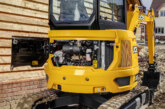In confronting climate change Costain has a plan – and the procurement and operation of plant and machinery is at its very heart. Construction Plant News Editor, Lee Jones investigates
Whilst sustainability is just about the biggest issue we face as a species, when it comes to behavioural change, it is relatively small steps that can come together to make a real difference. With its Climate Change Action Plan, Costain is putting that principle into practice and achieving tangible improvements across the whole of its business in the process.
“Our plan sets out what Costain is going to do to achieve Net Zero between now and 2035 at the latest,” explains Group Climate Change Director, and architect of the initiative, Lara Young. “It builds on more than a decade of previous emissions-reducing policies, and the lessons that have been learned.”
First launched in 2020, it is a strategy that will target reductions in the company’s carbon footprint across its key areas of operation – including a zero emissions fleet – but just what does this currently look like to the boots on the ground? The easiest element for any fleet manager to influence is emissions and this has been reflected by a focus on unnecessary idling. As an industry, machines can still be idling for an average of 35-45% of the time they are in operation and that represents a significant waste of energy and unnecessary amount of emissions.
“It’s an easy win in terms of reducing the environmental impact of a project and is an equally good starting point in driving behavioural change,” Lara explains. “We know it’s an issue for the industry at large but, when we started on our journey, there was little reliable data available that demonstrated the scale of the problem.” In order to harness that information Costain has introduced group wide agreements with strategic and preferred suppliers on technologies such as telematics and machine management. Every one of its contracts has then been tasked with achieving a year-on-year 20 per cent reduction in their baseline idling figures. That data is then reported on our group dashboard which is accessible to everyone from the executive board to site managers.
“We’ve been able to compile league tables that compare individual sites or teams,” Lara reveals. “We’re also continually interrogating how work is organised on the ground and subsequently introducing behavioural improvement plans. Our data identifies which teams and drivers are demonstrating best practice, which need further training and support, and we’re also investigating various retro-fit technologies for our machines.
Education
“In the latter context, hybrid and electric plant is an obvious solution, whilst ensuring that stop/start functionality on conventional internal combustion engine machines is actually activated. The reasons for unnecessary idling will differ from site to site, and the solutions should be introduced accordingly, but the most common theme is often education, and unlearning certain working methods.”
A similarly multi-faceted approach is in evidence with Costain’s attitude to alternative drivetrains, where a number of technologies have been embraced. Costain set out a mandate as far back as 2017 on minimum plant specs, and the guiding principle of its procurement is, wherever possible, to utilise machines with the lowest carbon footprint. In reality that can mean anything from battery-powered excavators, to hydrogen tower lights, or the use of hydro-treated vegetable oil (HVO), whilst equally driving the highest possible efficiencies from its conventionally powered units – hence the concern with idling.
Costain is also committed to moving the dial on client engagement on specification, whether that’s in engine tiers, challenging the types of machines that are used for what, and removing the need for the use of machinery at the design stage. The greenest form of energy is always the one you don’t use. That’s why the Climate Change Action Plan focuses on ensuring that multi-tasking pieces of construction plant are deployed, or plant requirements are eliminated from a project entirely.
The company also works directly with manufacturers to provide an active test bed for new technologies and provides invaluable feedback on the results. These often require different organisational requirements – mostly obviously ensuring the infrastructure exists on site to charge electric machinery at the earliest possible stage, for instance – and a contractor that occupies multiple sectors is ideally placed to determine what is ultimately practicable. Costain is exploring how hydrogen can be manufactured cleanly and transported to site, for example, and how the infrastructure around zero emissions technologies can be made available.
Plan of action
“There is a huge amount of data that informs the plan,” Lara adds, “but that will always be at its most effective when it is translated into simple leading indicators which are applied across the whole of the business rather than on flagship projects. If you are to achieve net zero across the board you need a plan for every stage, but a shift in mindset will also be demanded. We can get there without the support of our supply chain and client base and there’s no reason why the successes and lessons we’ve learned can’t be shared with the sector as a whole.”
So, in that spirit of collaboration, what advise does she offer other organisations that may be only just beginning their net zero journey? “There is now a huge amount of momentum behind the climate change agenda, but it’s important that they don’t become New Year’s Resolutions – there needs to be follow through. What is required is clarity on what can be addressed first and quickly without trying to tackle the whole carbon reduction and sustainability issue in one go, which is an overwhelming and quite daunting proposition. Keep it simple, don’t over complicate it, or get lost in the data.”
“Make sure ownership and accountability is a part of the plan – by holding individuals and companies to account. At the same time, it can’t just be about penalties because positive reinforcements and incentives should equally be in place.”










